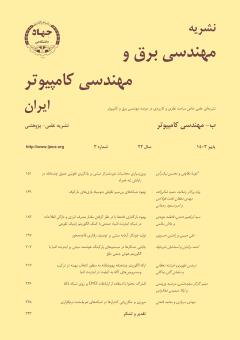جایابی حسگرها در سیستمهای پارکینگ هوشمند مبتنی بر اینترنت اشیاء با الگوریتم هوش جمعی ملخ
محورهای موضوعی : مهندسی برق و کامپیوتر
احمد براتیان
1
,
اسماعيل خيرخواه
2
![]()
1 - گروه مهندسی کامپیوتر، واحد مشهد، دانشگاه آزاد اسلامی، مشهد، ایران
2 - گروه مهندسی کامپیوتر، واحد مشهد، دانشگاه آزاد اسلامی، مشهد، ایران
کلید واژه: الگوریتم بهینهسازی ملخ, پارکینگ هوشمند, جایابی حسگرها, موقعیتیابی حسگرها,
چکیده مقاله :
با توجه به رشد جمعیت شهرها و تعداد وسایل نقلیه که به صورت تصاعدی در حال افزایش است، یک چالش در پارکینگها، جایابی وسایل نقلیه است. در یک سیستم پارکینگ هوشمند، راننده میتواند بدون تأخیر و با صرف انرژی کمتر پارک کند؛ ولی الزام آن استفاده از حسگرها (جای پارک خالی) و راهنماهای پارکینگ برای این منظور است. با پیشرفت تحقیقات در اینترنت اشیا، محققان در سیستم پارکینگ هوشمند مبتنی بر حسگرهای بیسیم، راهکارهای امیدوارکنندهای ارائه نمودند. از جمله این تحقیقات، استفاده از الگوریتم گرگ خاکستری (GWO) در موقعیتیابی بهینه حسگرهای بیسیم در محیط اینترنت اشیای پارکینگ است. در این مقاله با توجه به قدرت جستجو و همگرایی بالای الگوریتم بهینهسازی ملخ (GOA) برای اولین بار از این الگوریتم در جایابی حسگرهای بیسیم در پارکینگ استفاده شده است. الگوریتم بهینهسازی ملخ برای مشخصکردن بهترین گرههای لنگر برای جمعآوری داده از سایر حسگرها بهکار میرود؛ به طوری که بتواند خطای موقعیتیابی و میزان مصرف انرژی حسگرها را کاهش و طول عمر آنها را افزایش دهد. نتایج نشان داد که روش پیشنهادی توانسته به طور میانگین بهبود %92/5 در کاهش خطای موقعیتیابی، %43/6 در کاهش میزان مصرف انرژی و %23/6 در افزایش میزان طول عمر شبکه نسبت به الگوریتم گرگ خاکستری داشته باشد. همچنین روش پیشنهادی توانسته زمان بیشتری برای مرگ اولین گره داشته باشد و این یک مزیت مهم در پارکینگهای هوشمند بوده است؛ زیرا کارایی تمام حسگرها در محیط پارکینگ الزامی میباشد.
Considering the growth of the population of cities and the number of vehicles that are increasing exponentially, a challenge in parking lots is the positioning of vehicles. In a smart parking system, the driver can park without delay and by spending less energy; But its requirement is to use sensors (empty parking spaces) and parking guides for this purpose. With the progress of research in the Internet of Things, researchers have provided promising solutions in the smart parking system based on wireless sensors. Among these researches is the use of the gray wolf algorithm (GWO) in the optimal positioning of wireless sensors in the Internet of Things parking environment. In this article, due to the search power and high convergence of the Grasshopper Optimization Algorithm (GOA), this algorithm is used for the first time in the positioning of wireless sensors in the parking lot. The grasshopper optimization algorithm is used to determine the best anchor nodes to collect data from other sensors; So that it can reduce the positioning error and energy consumption of the sensors and increase their lifespan. The results showed that the proposed method was able to achieve an average improvement of 5.92% in reducing the positioning error, 6.43% in reducing the amount of energy consumption and 23.6% in increasing the lifetime of the network compared to the gray wolf algorithm. Also, the proposed method has been able to have more time for the first node to die, and this is an important advantage in smart parking because the efficiency of all sensors in the parking environment is required.
